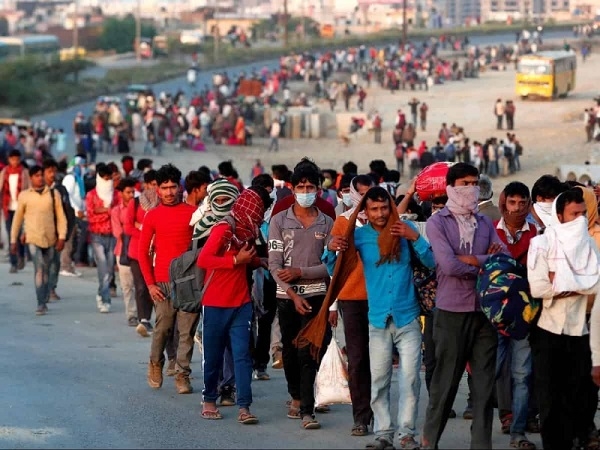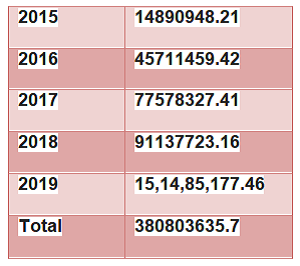Amid CoronaVirus outbreak, Foreign Funded NGO spreads myths through its survey report
An NGO which doesn't have any previous track record of research publishes a report on the grim situation of construction workers in India. Swiftly, every other mainstream media portal carries out this story (within 24 hours).
"Jan Sahas" a Dewas (M.P.) based NGO has recently released this survey report. Jan Sahas under their mission statement works for socially excluded communities. So we decided to go into details.

To our surprise, Jan Sahas has been well funded by foreign organizations. You can check that here. Following are the figures of the year by year foreign funding, they have received.

After going through the above numbers we doubt the modus operandi of this organization. Why does "Jan Sahas" an NGO receives funding from organizations like "Christian Aid" and "Caritas". These organisations are known for religious conversions and their missionary work.
Report on Migrant Construction Workers:
This the first time that this NGO has released any survey report. As said earlier many from mainstream carried this story.
News Published in Hindu
News18 India
This sudden illumination of media houses prompted team NewsBharati to analyze this survey report and Vola! what did we find? A report which is full of contradiction.
This survey claims that there is a very dreadful situation of the construction workers due to the lockdown. The study indicates 42% of workers don't even have ration for the day and are forced to migrate back to their native place.
As per the report, this entire exercise happened through telephonic conversations with the workers. The database (of 60,000 workers) was already available with Jan Sahas. Sampling size was 5000 workers in which they were able to reach 3196 workers (Page 8).
While going through the report we came across irregularities which we believe impedes the entire objective of this study.
To start with, where does this data of 60K workers come from? How did they gather it? When did they gather it? As per the report, this data contains names and numbers of workers. The entirety of construction workers fall under the unorganized sector so this data must be having some kind “shelf life”. So the question is, is this right decision to consider such data as the source for study? There are many possibilities such as workers may already have moved to their native places or shifted to some other work such as agriculture.
Next thing which bothers is how they decided to go for a sample of 5000. What is the bifurcation of this data? Gender, Age, Geographical locations?. The only answer we get here is data is of the workers who belong to UP, MP and Rajasthan. Here is the question of proper representation and this data fails to answer this. This data represents neither India nor central India. This is a flaw in choosing respondents.
This study claims to be a representation of 55 million (Page 16) labourers. In contradiction of numbers, the sample they could amass is of 3196 respondents only. If we break down this to the percentage of representation it comes to 0.0058 %. This is very slippery even for sampling methodology and raises more doubts.
(1)
To elaborate more here is one of the finding(1) of the report which claims that 99.2% workers have Aadhar Card, 86.7% have bank accounts (or PM Jan Dhan Yojana A/c), 61.7% have ration cards, 27.3% have BPL cards, 26.9% have MGNREGA card,18.8% BOCW card, 4.3% have Antyoday Cards (Page 17). With findings (1) report claims that workers don't have access to schemes or they are not aware of it.
(2)
Now in another finding(2) of the report which claims that the government has announced 1.7 Lakh Cr. relief which aims to help them with ration through Public Distribution System (PDS). This will benefit 800 million people overall. Beneficiaries are entitled to receive 35 kilograms (Kg) of food grains per family per month, at the rate of 3 Rupees/Kg for rice, 2 Rupees/Kg for wheat and 1 Rupee/Kg of cereals.
(1) + (2)
If we put findings of (1) and findings of (2) together i.e. 61.7% of ration card holders + 27.3% BPL holders. It totals to 89%. So in a way, total beneficiaries of just (1) and (2) are 89%.
(3)
Again this is the same case with BOCW. The benefit of 32,000 Cr. rupees (3) announced through The Building and Other Construction Welfare Fund (BOCW) (Foreword Para 2).
(1) & (3)
(1) i.e. 18.8% of BOCW cardholder will be benefited by 32,000 Cr (3) rupees.
It appears that one or other way these 55 million will be benefited from either PMJDY or BOCW or Ration Card/BPL Card or MGNREGA.
Than why researchers don't want to go with their findings? why contradict in their recommendations. It is clear that, If a worker has missed one or the other scheme still s/he will be benefited. Governments (Center and State) have made sure that no one is left out of benefit
Above are the few examples. If you go in detail you will find this report full of such anomalies. In a hurry or predominantly researchers have contradicted “findings and suggestions”. It is up to them to answer but this raises a serious question of the authenticity of the report for sure.

